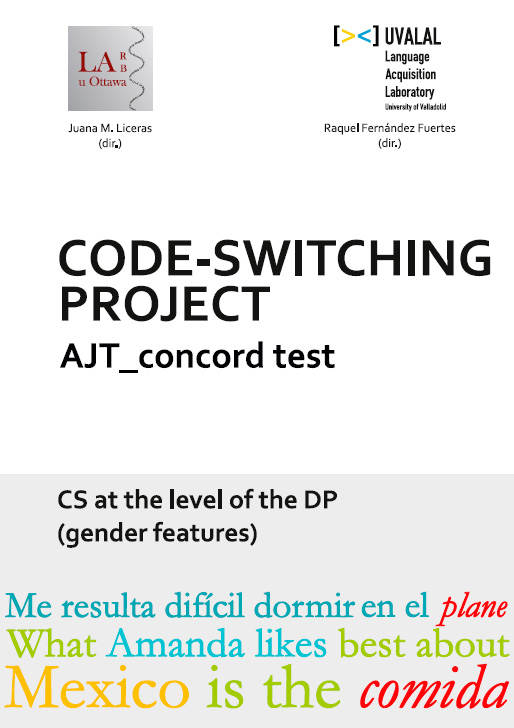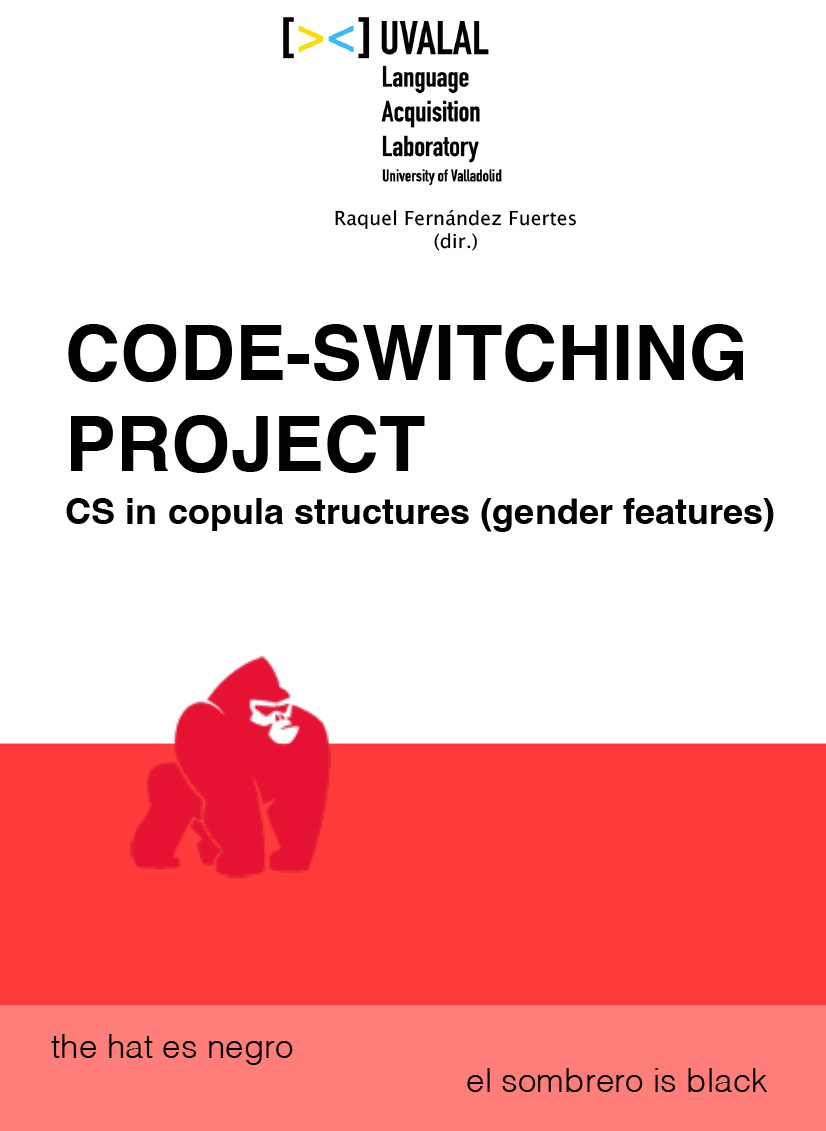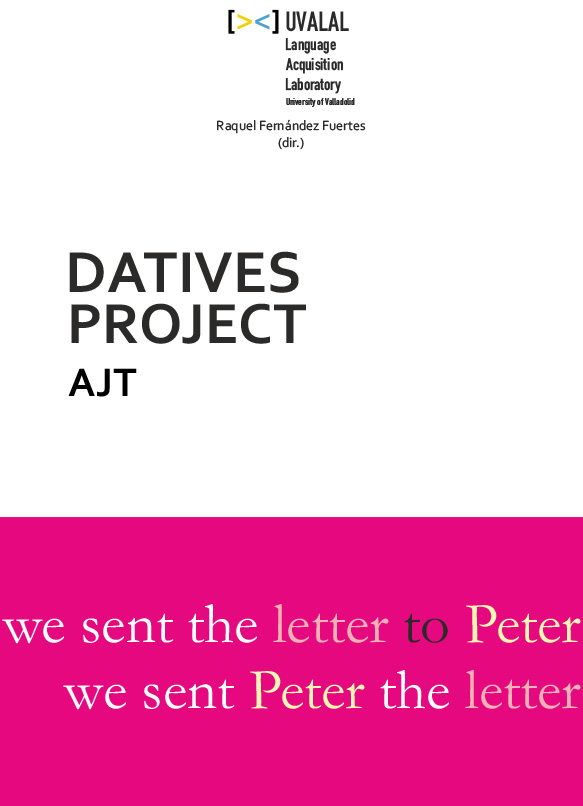
code-switching_concord
- test: participants have to rate a series of experimental structures using a 1-to-4 scale presented via emoticon faces (1 = sounds bad; 4 = sounds good). The structures involve English/Spanish code-switching at the DP level:
The house is in the bosque
Se están mirando el face
El gato está junto a la house - implementation: offline
- languages: English, Spanish
- participants
children: 32 (L1 Spanish-heritage English); 43 (L1 English-heritage Spanish); 54 (L1 Spanish-L2 English); 22 (L2 Spanish)
adults: 8 (L1 Spanish-heritage English); 45 (L1 English-heritage Spanish); 106 (L1 Spanish-L2 English) - objective: to determine the preference for the Spanish or the English functional category in code-switched constructions as well as gender preferences in the case of Spanish determiner switches; and to link these preferences to the concept of language dominance and to how features are represented in the bilingual mind

code-switching_agreement
- test: participants have to rate a series of experimental structures using a 1-to-4 scale presented via emoticon faces (1 = sounds bad; 4 = sounds good). The structures involve English/Spanish code-switching at 2 grammatical points:
DP subject + copula verb with adjective
The house es bonita / bonito
La casa is nice
DP or pronominal subject + verb
La señora / Ella hugs her sister
The teacher / She lee una revista - implementation: offline
- languages: English, Spanish
- participants
children: 33 (L1 Spanish, heritage English); 43 (L1 English, heritage Spanish);
22 (L1 English-L2 Spanish)
adults: 45 (L1 English, heritage Spanish); 8 (L1 Spanish, heritage English);
110 (L1 Spanish-L2 English) - objective: to determine how gender and person features shape the code-switching preferences of different groups of bilinguals and to link these preferences to the concept of language dominance and to how features are represented in the bilingual mind

code-switching_copula
- test: participants have to read in silence a series of sentences some of which are in English, some in Spanish and some involve English-Spanish code-switching. Then they have to rate each sentence using a 1-to-4 scale presented via emoticons (1 = very bad; 4 = excellent)
- implementation: online via Gorilla Experiment Builder (www.gorilla.sc; Anwyl-Irvine et al. 2018)
- languages: English, Spanish
- participants
children: 27 (L1 Spanish-L2 English); 5 (L1 Spanish, heritage English)
adults: 35 (L1 Spanish-L2 English) - objective: to explore how the properties of the two language systems interact in the mind of the bilingual; in particular, the focus is placed on the directionality of the switch and on the type of implicit gender agreement mechanism in switched copulative constructions with an adjective as subject complement

dative alternation
- test: participants are presented with a sentence which they have to evaluate using a 1-to-4 scale (1 = very bad; 4 = excellent). The experimental structures involve different types of dative constructions: to-datives and for-datives that alternate as double object constructions:
I told the story to Mary / I told Mary the story
I baked the cake for our mum / I baked our mum a cake - implementation: offline and online via Gorilla Experiment Builder (www.gorilla.sc; Anwyl-Irvine et al. 2018)
- language: English
- participants
adults: 10 (L1 Spanish-L2 English); 10 (L1 English, control) - objective: to address potential crosslinguistic influence effects in the L2 English of L1 Spanish speakers, given that dative alternation is possible in English but not in Spanish; and to link these effects to the type of dative construction, as well as to the participants’ L2 proficiency level

objects
- test: participants are presented with a dialogue between two people, and they have to rate the sentence produced by the second person using a 1-to-4 scale presented via emoticons (1 = very bad; 4 = excellent). The experimental structures involve different types of mono-transitive verbs (i.e., pure versus mixed, simple versus phrasal) and different types of direct object forms (i.e., determiner phrases, overt pronouns, and null pronouns) and direct object reference (i.e., [+/- generic]):
John loves pets. He has a dog.
The umbrella is wet. Just put it by the door.
My laptop doesn’t work. He can repair.
It is very hot today. Then, take off your jacket.
Who invented this story? I made it up.
Are you watching TV? No, you can turn off.
What are you doing? We are writing a story.
Did you understand Sarah? No, I couldn’t hear her.
I have a new book. My sister would like to borrow.
The bike is expensive. I’m saving for it. - implementation: offline and online via Gorilla Experiment Builder (www.gorilla.sc; Anwyl-Irvine et al. 2018)
- language: English
- participants
adults: 43 (L1 Chinese-L2 English); 10 (L1 English, control) - objective: to address potential crosslinguistic influence effects in the L2 English of L1 Chinese speakers, given that null objects are much less restricted in Chinese than in English; and to link these effects to verb type and to verb complexity as well as to the participants’ L2 proficiency level

N modification
- test: participants are presented with a picture and a determiner phrase (DP) that matches the picture, and they have to rate the DP using a 1-to-4 scale presented via emoticons (1 = very bad; 4 = excellent). The experimental structures involve two types of DPs: noun-noun compounds and adjective-noun strings
- implementation: offline (pen-and-paper); 3-year longitudinal data
- language: English
- participants
children: 96 (L1 Spanish-L2 English); 11 (L1 English, control) - objective: to analyze word-order issues within the DP involving nouns pre-modified by another noun (NN compounds) and nouns pre-modified by an adjective (Adj+N combinations); to address potential crosslinguistic influence effects in the L2 English of L1 Spanish children; and to link these effects to length of exposure and explicit instruction
